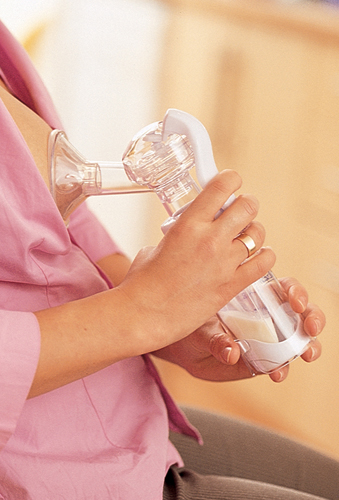Structure of breasts
Comfortable feeding positions
Lying down:
Some mothers find that
breast-feeding lying down is the best position for them, particularly if
they have had a cesarean delivery. Keep your baby's body tucked in
close to you and her head level with your breast so that she doesn't
have to pull on your nipple.

Tummy-to-tummy:
Sitting
comfortably with your back and arms well supported by cushions, hold
your baby so that you are tummy-to-tummy, supporting her with one arm.

Myths and misconceptions Is it true that…
| Q: |
I've got inverted nipples so I can't breast-feed?
|
| A: |
Babies breast-feed not “nipple-feed” so if your baby latches on well, this shouldn't cause difficulties.
About 10 percent of women have flat or inverted nipples. The best way
to find out whether you can breast-feed is simply to try. There are
various techniques that may help—ask for help from your midwife if
you're having problems.
|
| Q: |
My milk can “dry up” just like that?
|
| A: |
This is unlikely. Aside from daily variations, milk production doesn't change suddenly.
There are things which may make it seem as if your milk has decreased,
such as an increase in your baby's appetite (so-called growth spurt) or
certain medications (for example, contraceptive pills). Ask for help if
you need it, but don't worry too much—your milk supply is triggered by
sucking stimulation, and should be just right for your baby's
nutritional needs.
|
| Q: |
I've had a breast augmentation so I can't breast-feed?
|
| A: |
This isn't
true: many women can breast-feed after implants, but not all. In most
cases the implant is separated from the breast by a layer of muscle, but
there may be some trauma to the tissue in the placement process. This
may decrease the likelihood of successful breast-feeding.
If the milk comes in successfully, most women with implants can
breast-feed safely. If you're thinking about getting implants but want
to breast-feed, it's safest to wait until after you've given birth and
fed your last baby.
|
Expressing breast milk Providing additional milk supplies
You can express breast milk
as soon as you feel ready after the birth, although some women prefer
to wait until breast-feeding is established, at around two to four
weeks. Expressing milk means your partner can help with feedings and you
may be able to sleep through a feeding.
| Q: |
How is it done?
|
| A: |
Most women use a pump to express their milk. There are many
different types available, ranging from manual to electric ones. The
other way to express your milk is manually. To do this, support your
breast with one hand, making a c-shape toward the back of your breast
and gently squeeze in a downward motion, moving toward the nipple; stop,
and then repeat until you have enough milk. You will soon learn where
the best place is to put your finger and thumb. Sometimes it is
difficult to get a “letdown reflex” when you are expressing—try thinking
of your baby and you should soon be making lots of milk.
|
| Q: |
How should breast milk be stored?
|
| A: |
It is important that you put the expressed breast milk into a
sterile bottle liner or a sterile bottle. This can then be stored in the
back of the fridge for 3–8 days, or in the freezer for up to three
months. Label each bottle or container with your name (if your baby will
be with others at a day-care center), and the date and time you
expressed it. To defrost the milk warm it gently in a bowl of hot
water—don't use your microwave. Do not keep milk in the fridge door
since the temperature fluctuates.
|
Before using a breast pump, try to stimulate the letdown reflex
by using a warm washcloth, taking a warm shower, or looking at your
baby.

When expressing by hand, use the techniques shown in the image
to stimulate the milk flow and also hold your breast in one hand while
you gently massage it with your other hand. Then, with your fingers
underneath the nipple and your thumbs on top, gently start to squeeze
around the nipple to release the milk.